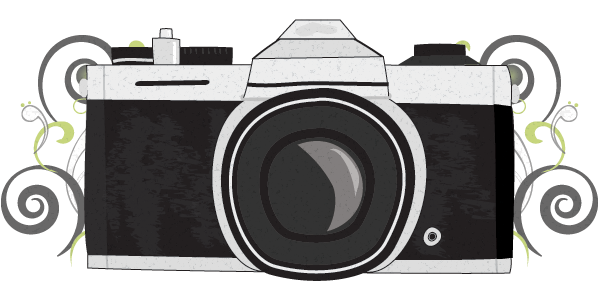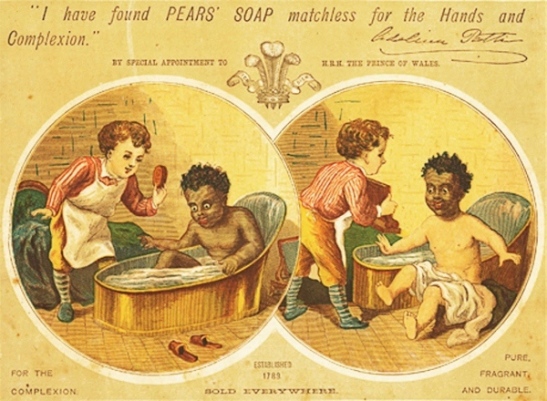Categories: Image from Before 1900 (This image is from 1783), Commerical Advertising
Through the Pears’ Soap advertisement, it is extremely apparently that the Victorian societal values were deeply embedded in the advertising industry. During this time, Britain had experienced enormous development in their economy due to their colonization of islands like New Guinea and West Africa to produce cheap cotton and palm oil. (McClintock 34) This lead to the creation of the first bar of mass produced soap. As mentioned in Imperial leather, ” Soap was credited not only with bringing moral and economic salvation to Britain’s “great unwashed” (McClintock 34) but also with magically embodying the spiritual ingredient of the imperial mission itself. ” Here, the strict Victorian rules about cleanliness were personified into a bar of Pears’ soap, to ‘clean’ these so-called impure people.
Ads had the ability to supress coloured people in the working class, as their negative stereotypes were carried from the advertising world and onto people’s lives. Although not explicitly stated, the coloured person is always represented as “different,” even in the positioning between the two characters in this ad. To top it off, the characters are not realistic portrayals of actual toddlers. In Pear’s ad, the impression of a black person’s skin is exaggeratedly dark, and is paired with bright red lips to create this caricature of a typical black person would look and act like as a comedic effect. This gives an illusion to white consumers, that they should view black people as lazy, dumb, or dirty.
The white boy is well dressed and the black boy is half naked with only a cloth covering his lower body. The posture of the well-to-do-white boy suggests that he is assuming the role of a teacher towards the other boy. Pears is implying that the first boy, or white boys in general, are more knowledgable than those of coloured skin, therefore he should teach others about pears soap to become more white like himself. After coming out of the bath, the black child’s body is completely white due to the suggested purification effects of Pears’ soap. The black boy has a goofy smile on his face, which enhances society’s preexisting negative bias towards black people being a very primitive bunch, in contrast with Caucasians. Unlike the black boy, the white boy has a calm expression, to show that he is elegant and of a higher class.
The world that is represented to us in the advertisement suggests that white people are naturally more powerful and intelligent than those with coloured skin. This suggests that it is part of the white person’s duty to show others how to clean themselves, and their metaphorical dirty feeling of being a coloured person. McClintock’s Imperial Leather, talks about another ad from Pears’ soap, about how the White Man’s Burden is all about “teaching the virtues of cleanliness.” Apparently, back in the day, “Soap and cleaning rituals became central to the demarcation of body boundaries andthe policing of social hierarchies.” (McClintock 33) Using Pears’ soap was equivalent to having a high status, which is what the typical white person was born privileged with. Pears’ soap was more than just a bar of soap; it embodied the ideals of the upper class into a consumer products and acted as an ethnic cleanser.
Spectators view this ad in the white, upper class and typically male’s gaze. The target audience of this product is directed towards either white people or black people who want to be white. The formal, upper class language used here suggest that the soap is not something that is able to be purchased by low class. The color white is associated with purity, innocence and cleanliness while black is associated with dirt, negativity, evil and all that is opposite of the colour, white. The slogan, “I have found PEARS’ SOAP matchless for the Hands and Complexion ” assumes that all people want to be white as it is associated with the higher classes. Near the edge of the advertisement, the words “pure, fragrant, and durable” are used to describe the white person and the soap’s practical and metaphorical usages. Pears’ Soap is suggesting that if you use this soap, you can become as innocent as pure as a white person, to the point where you can even clean off your natural skin colour.
In stuart Hall’s book, he talks about how we must analyze the privileged meaning in the visual texts we are analyzing. (Hall 229) Specifically, he’s asking if the subject in our medium is seen as a hero or villainous character. The white child in Pears’ advertisment is seen as a hero to the black child, which is important because it seems like the latter child is being saved from his own skin colour with the aid of the white child. Just because they are different, does not mean that they are subpar to white people. “The racialized discourse is structured by a set of binary oppositions. There is the powerful opposition between ‘civilization’ (white) and ‘savagery'(black). There is the opposition between the biological or bodily characteristics of the ‘black’ and ‘white’ ‘races’, polarized into their extreme opposites-each the signifiers of an absolute different between human ‘types’ or species.” (Hall 232).
Hall says “the discourse of written language and the discourse of photography-are required to produce and ‘fix the meaning.” (228) This means that visual images do not mean very much when it is standing alone. Images tell us a story about the cultural narratives of our society, which are stories that we tell ourselves for us and for other people. (Lecture 3)
Stereotyping, not only fixes meaning to preserve discourse, but is a reflection of power imbalances in our society and reduces the entire ethnic group of people into a flat, typical type of character. (Lecture 5) We may understand the ad differently if our society was not so racist. Through science, we know such a thing like ‘race’ doesn’t exist, as everyone is the same on a biological level. To the black community and everyone in general, this ad is seen as racist and makes no sense whatsoever due to the exaggeration of the soap’s effects as a cleanser. We all know that black people are not white underneath the soap, that is why it is so appauling.
As advertisements become more mass produced and people buy into the ads, it confirms the act of being racist. Having these stereotyped ideas of black people put on print gives it more authenticity than just words. Advertising is not a one way street; ads are an amplified version of the values from the reality we live in.

